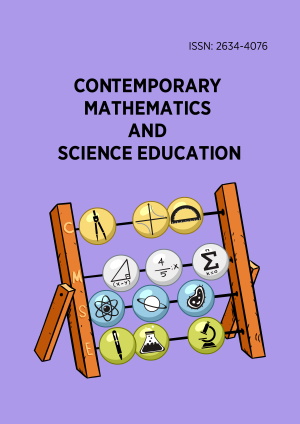Research Article
Undergraduate physics students' understanding of thermal phenomena in everyday life
More Detail
1 Department of Primary Education, University of Ioannina, Ioannina, GREECE* Corresponding Author
Contemporary Mathematics and Science Education, 4(2), July 2023, ep23023, https://doi.org/10.30935/conmaths/13406
Published Online: 18 June 2023, Published: 01 July 2023
OPEN ACCESS 1938 Views 1343 Downloads
ABSTRACT
This paper presents the results from postgraduate students in the physics department at University of Ioannina in Greece about their perceptions of thermal phenomena. For this purpose, an open-ended questionnaire comprised questions about heat transfer and conductance in everyday life. The results showed that many students need clarification about the various concepts of thermal phenomena and demonstrate the conflict between everyday experience and scientific models in explaining phenomena.
CITATION (APA)
Stylos, G., & Kotsis, K. T. (2023). Undergraduate physics students' understanding of thermal phenomena in everyday life. Contemporary Mathematics and Science Education, 4(2), ep23023. https://doi.org/10.30935/conmaths/13406
REFERENCES
- Adadan, E., & Yavuzkaya, M. N. (2018). Examining the progression and consistency of thermal concepts: A cross-age study. International Journal of Science Education, 40(4), 371-396. https://doi.org/10.1080/09500693.2018.1423711
- Alwan, A. (2011). Misconception of heat and temperature among physics students. Procedia-Social and Behavioral Sciences, 12, 600-614. https://doi.org/10.1016/j.sbspro.2011.02.074
- Bonidis, K. (2004). The content of school textbook as an object of research. Metechmio.
- Chiou, G.-L., & Anderson, R. (2010). A multi-dimensional cognitive analysis of undergraduate physics students’ understanding of heat conduction. International Journal of Science Education, 32(16), 29. https://doi.org/10.1080/09500690903258246
- Chu, H.-E., Treagust, D. F., Yeo, S., & Zadnik, M. (2012). Evaluation of students’ understanding of thermal concepts in everyday contexts. International Journal of Science Education, 34(10), 1509-1534. https://doi.org/10.1080/09500693.2012.657714
- Garbett, D. (2011). Constructivism deconstructed in science teacher education. Australian Journal of Teacher Education, 36(6), 36-49. https://doi.org/10.14221/ajte.2011v36n6.5
- Gavrilas, L., & Kotsis, K. T. (2023). Assessing elementary understanding of electromagnetic radiation and its implementation in wireless technologies among pre-service teachers. International Journal of Professional Development, Learners, and Learning, 5(2), ep2309. https://doi.org/10.30935/ijpdll/13191
- Gavrilas, L., Kotsis, K. T., & Papanikolaou, M. (2022). Attitudes and behaviors of university students towards electromagnetic radiation of cell phones and wireless networks. Aquademia, 6(2), ep22009. https://doi.org/10.30935/aquademia/12393
- Georgiou, H., & Sharma, M.D. (2012) University students’ understanding of thermal physics in everyday contexts. International Journal of Science and Mathematics Education, 10, 1119-1142. https://doi.org/10.1007/s10763-011-9320-1
- Halliday, D., Resnick, R., & Walker, J. (2013). Fundamentals of physics. John Wiley & Sons.
- Hewitt, P. G. (2002). Conceptual physics. Pearson.
- John-Steiner, V., & Mahn, H. (1996). Sociocultural approaches to learning and development: A Vygotskian framework. Educational Psychologist, 31(3-4), 191-206. https://doi.org/10.1080/00461520.1996.9653266
- Kotsis, K. T., Stylos, G., Houssou P., & Kamaratos, M. (2023). Students’ perceptions of the heat and temperature concepts: A comparative study between primary, secondary, and university levels. European Journal of Education and Pedagogy, 4(1),136-144. https://doi.org/10.24018/ejedu.2023.4.1.577
- Kotsis, K., & Kotsinas, G. (2011). Perceptions of primary education teachers about visible light. In Proceedings of the 7th Panhellenic Conference on Teaching Natural Sciences and New Technologies in Education (pp. 533-541).
- Kruatong, T., Sung-Ong, S., Singh, P., & Jones, A. (2006). Thai high school students’ understanding of heat and thermodynamics. Kasetsart Journal of Social Sciences, 27(2), 321-330.
- Olympiou, G., & Zacharias, Z. (2009). A comparative study of the effectiveness of real or virtual laboratory experimentation in achieving conceptual understanding in physics. In P. Kariotoglou, A. Spyrtou, & A. Zoupidis (Eds.), Proceedings of the 6th Panhellenic Conference on Teaching Natural Sciences and New Technologies in Education (pp. 621-629).
- Skoumios, M., & Xatzinikita, B. (2000). Student models of heat, temperature, and thermal effects. Physics Review, 31, 58-71.
- Stylos, G., Sargioti, Aik., Mavridis, D., & Kotsis, T. K. (2021). Validation of the thermal concept evaluation test for Greek university students’ misconceptions of thermal concepts. International Journal of Science Education, 43(2), 247-273. https://doi.org/10.1080/09500693.2020.1865587
- Stylos, G., Siarka, O., & Kotsis, K. T. (2023). Assessing Greek pre-service primary teachers’ scientific literacy. European Journal of Science and Mathematics Education, 11(2), 271-282. https://doi.org/10.30935/scimath/12637
- Tsichouridis, X., Vavougios, D., & Ioannidis, G. (2009). Didactic utilization of construction skills of students for the study of heat transfer phenomena using new technologies. In P. Kariotoglou, A. Spyrtou, & A. Zoupidis (Eds.), Proceedings of the 6th Panhellenic Conference on the Teaching of Sciences and New Technologies in Education (pp. 886-894).
- Vavoulioti, A. R., Stylos, G., & Kotsis, K. T. (2023). Acceptance of nuclear energy by pre-service teachers in Greece. Aquademia, 7(1), ep23004. https://doi.org/10.30935/aquademia/13205
- Vosniadou, S. (1994). Capturing and modeling the process of conceptual change. Learning and Instruction, 4, 45-69. https://doi.org/10.1016/0959-4752(94)90018-3

 The articles published in this journal are licensed under the CC-BY Creative Commons Attribution International License.
The articles published in this journal are licensed under the CC-BY Creative Commons Attribution International License.